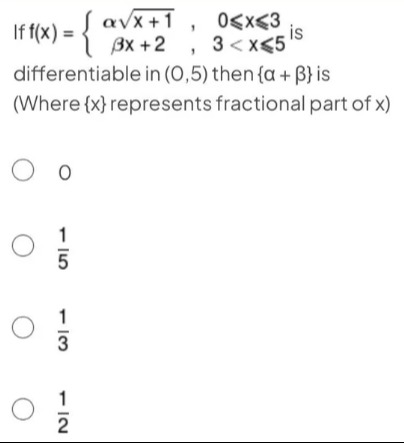Question
Question: If $f(x) = \begin{cases} \alpha \sqrt{x+1}, & 0 \leq x \leq 3 \\ \beta x+2, & 3 < x \leq 5 \end{case...
If f(x)={αx+1,βx+2,0≤x≤33<x≤5 is differentiable in (0,5) then {α+β} is
(Where {x} represents fractional part of x)

A
0
B
51
C
31
D
21
Answer
0
Explanation
Solution
To ensure differentiability of the piecewise function f(x) at x=3, we need to ensure both continuity and equality of derivatives at that point.
-
Continuity at x=3: We need to ensure that the function values match at x=3:
α3+1=β(3)+2 2α=3β+2(1) -
Differentiability at x=3: We need to ensure that the derivatives match at x=3. First, find the derivatives of both pieces: For 0≤x≤3:
f′(x)=2x+1α f′(3)=23+1α=4αFor 3<x≤5:
f′(x)=βEquating the derivatives at x=3:
4α=β(2) α=4β -
Solving for α and β: Substitute α=4β into equation (1):
2(4β)=3β+2 8β=3β+2 5β=2 β=52Now, find α:
α=4β=4(52)=58 -
Finding {α+β}:
α+β=58+52=510=2The fractional part of 2 is:
{2}=0
Therefore, {α+β}=0.
